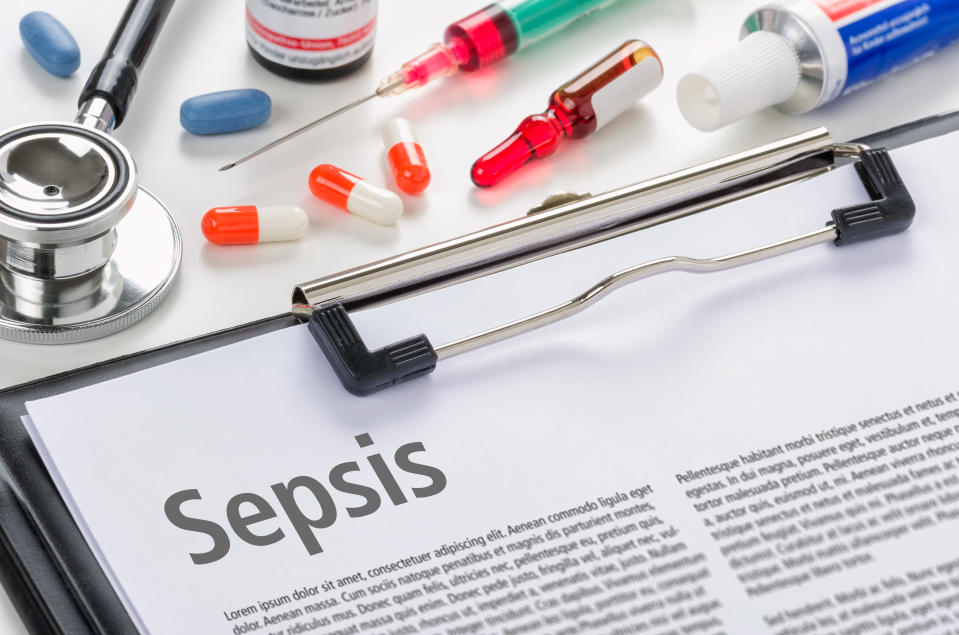Sepsis 'behind one in five deaths worldwide' - what is the condition?

Sepsis may be behind one in five deaths globally, research suggests.
Scientists from the universities of Pittsburgh and Washington found 48.9m people developed the life-threatening condition in 2017, of which 11m died.
This represents one in five fatalities worldwide, twice as many as previously believed.
“We are alarmed to find sepsis deaths are much higher than previously estimated, especially as the condition is both preventable and treatable,” study author Dr Mohsen Naghavi, from the University of Washington, said.
READ MORE: Woman fears for unborn baby after botched tummy tuck left her battling sepsis
When fighting an infection, the body releases chemicals into the bloodstream to help eliminate the offending pathogen.
Sepsis occurs when the body over-reacts, throwing the chemicals out of balance so they damage vital organs.
This should not be confused with septicaemia, or blood poisoning, which comes about when bacteria enter the bloodstream.
To understand the global burden of sepsis, the scientists used studies and hospital records to analyse cases and deaths between 1990 and 2017.
Rates are improving, with fatalities falling by 30% from 15.7m to 11m, results - published in The Lancet - show.
The number of cases also went down by 19% from 60.2m to 48.9m.
Yet, the condition is still a real concern, particularly in developing countries, where 85% of cases occur.
Sub-Saharan Africa; the South Pacific islands near Australia; and south, east and southeast Asia suffer most.
“I've worked in rural Uganda and sepsis is what we saw every single day,” lead author Dr Kristina Rudd said.
“Watching a baby die of a disease that could have been prevented with basic public health measures really sticks with you.
“But sepsis is still a problem here in the US, where it is the number one killer of hospital patients.”
READ MORE: Baby loses his limbs to sepsis following an undiagnosed throat infection
The scientists found women are more at risk than men.
Children are also vulnerable, with over 40% of cases occurring in children under five.
Sepsis is often considered an “intermediate” cause of death, as it occurs in response to an underlying infection.
The scientists found lower respiratory infections, like pneumonia or tuberculosis, were the most common underlying cause of sepsis-related deaths in both 1990 and 2017.
“So what is the solution?,” Dr Rudd said. “Well, to start with it's basic public health infrastructure.
“Vaccines, making sure everyone has access to a toilet and clean drinking water, adequate nutrition for children and maternal health care would address a lot of these cases.
“Everyone can reduce their odds of developing it by getting the flu shot and the pneumonia vaccine when appropriate.
“Beyond that, we need to do a better job preventing hospital-acquired infections and chronic diseases, like diabetes, that make people more susceptible to infections.”

Who gets sepsis? What are the symptoms?
Sepsis can happen to anyone in response to any infection. Bacteria are usually to blame, however, even a cold can set the condition off in theory.
Those most at risk include the elderly, pregnant women, babies and those with chronic conditions or weak immune systems.
Symptoms can be vague and hard to spot, mimicking those of flu or a chest infection.
Babies and children may develop blue, pale or blotchy skin, which also affects their lips and tongue, according to the NHS.
READ MORE: What is sepsis? What are the early signs to look out for?
Some may also have a rash that does not fade when a glass is rolled over it, like with meningitis.
Difficulty breathing, a weak or high-pitched cry and disinterest in feeding or normal activities should also raise alarm bells.
Young sufferers may also be sleepier then normal or difficult to wake.
The above may also occur in adults, alongside confusion and slurred speech.
Also look out for vomiting, swelling or redness around a cut, a very high or low temperature, and a lack of urination.
Can sepsis be prevented? How is it treated?
Sepsis cannot always be prevented, however, staying up-to-date on vaccinations may help.
The NHS also recommends cleaning any wounds, taking antibiotics as prescribed and washing hands regularly.
If sepsis does develop, patients require immediate hospital treatment.
Failure to be treated early can lead to septic shock.
This occurs when the toxins produced by bacteria damage small blood vessels, causing them to leak fluid into surrounding tissue, according to NHS Inform.
The heart is then less able to pump blood, which lowers blood pressure, preventing it reaching vital organs.
Once in hospital, sepsis patients should be given antibiotics.
Some may require a ventilator to help them breathe and surgery to remove areas of infection.
Sepsis-shock sufferers may be given medication to increase blood flow and IV fluids.
Most sepsis patients make a full recovery, however, it can take time.
Post-sepsis syndrome can lead to fatigue, a lack of appetite, susceptibility to infections and even flashbacks or nightmares.
The Sepsis UK Trust has more information on the condition itself and post-sepsis syndrome.

